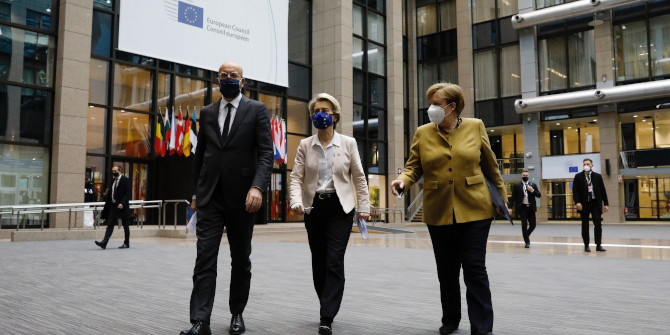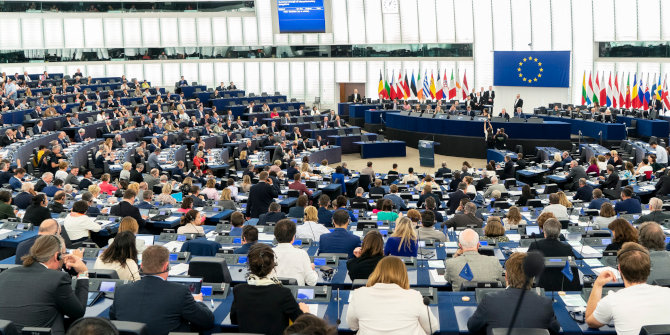How might the crisis brought on by Covid-19 affect the future of European integration? Sir Michael Leigh identifies two distinct interpretations of the pandemic so far: a scenario in which Covid-19 becomes the starting point for a relaunch of the EU, and an alternative path in which the crisis precipitates the EU’s disintegration.
The Covid-19 epidemic has been a testing time for the European Union, and for much of the world. Some see it as a pivotal experience for the EU, accelerating European integration in unexpected ways. Others see the epidemic as draining power from Brussels to national capitals, as states, and even regions and cities are the prime actors in efforts to bolster public health.
Two broad scenarios for the EU’s future encapsulate these different interpretations. These are not scientific scenarios, but rather narratives about how the EU may evolve. I call the first narrative “relaunch” – it lays out a path towards greater integration, based on trends visible today. The second narrative is called “disintegration,” which points to risks that could eventually lead to the EU’s collapse.
These two stories may seem like extreme cases. But they are not artificial constructs plucked from the air for the sake of argument. The most eloquent advocate of “relaunching” the EU is French President Emmanuel Macron, with the backing of German Chancellor Angela Merkel, and with the heads of EU institutions in supporting roles. Macron’s speeches, starting at the Sorbonne in 2017, as well as the “state of the Union” addresses of the two most recent Commission presidents are packed with concrete proposals for relaunching the EU.
Predictions or warnings of collapse do not come mainly from the usual suspects – Eurosceptics and extreme nationalists – but from mainstream pro-EU leaders and indeed academics and think-tankers. Chancellor Merkel in 2010, in the midst of the financial crisis, warned that the European Union itself could fail if the euro collapsed. This year Macron and Italian Prime Minister Giuseppe Conte both predicted the EU’s collapse unless it agreed to a generous Recovery Fund. The Polish Prime Minister spoke in December of the EU’s collapse if it persists with tough rule-of-law conditionality for the budget.
To be sure, such warnings are usually tactical, and in some cases cynical, intended to push others towards accepting the speaker’s preferred outcome to a contentious issue. Still, they resonate in the media and convey the message that collapse is thinkable. The academic literature, too, is filled with “obituaries” for Europe, “Euro-Tragedies”, studies of disintegration and dystrophies of what our continent will look like “after Europe.” An ECFR opinion poll last year showed that more than half the respondents in 14 countries believed that the EU is likely to collapse within a generation, even though a majority said that they themselves supported the European project.
These contrasting scenarios or narratives about the future of Europe should be tested rigorously using evidence on public opinion, trade, investment, capital flows, data exchange, transport, and other forms of political and economic inter-penetration. But for the present, we will make a brief qualitative review of whether the EU’s response to Covid-19 tends to sustain the “relaunch” or the “disintegration” hypothesis.
Relaunch
The philosophical foundation for the relaunch scenario is a version of the Monnet method, functionalism, and the theory of spill-over. Monnet has been quoted and misquoted lately about Europe being forged in adversity. This suggests that crises – like Covid-19 – can lead to steps forward that would otherwise have been unimaginable. These steps often occur as a result of the EU’s response to the unexpected consequences of earlier decisions.
Does the EU’s response to the epidemic comfort the relaunch scenario? According to this narrative, the EU’s reaction to Covid-19 responded to new demands and took the EU into new territory. The EU’s response improved its image and strengthened public trust – despite the worrying public health and economic situation that persists today and resistance to restrictive measures in several countries.
This positive narrative recalls that the Commission reacted to the initial shortage of personal protective equipment and masks by asking member countries to desist from export bans within the single market and that they promptly complied. The Commission then launched an entirely new activity, joint European procurement of personal protective equipment, ending Chinese and Russian “mask diplomacy” and, even more importantly, it introduced EU procurement of vaccines. The EU’s role in supplying vaccines, even if poorly understood, has improved the EU’s image in most member countries.
The Commission also put forward an innovative scheme to mitigate unemployment risks in the emergency (SURE). This involves loans at rates somewhat lower than otherwise available to national authorities. Headline figures in the billions of euros convey to the media and public opinion the message of European solidarity in a time of need.
The Commission has proposed a “health union” with a new agency (European Health Emergency Response Authority) in charge of stockpiling medical supplies and the existing European Centre for Disease Prevention and Control given more resources. These changes take the EU beyond its previous limited involvement in public health, which is mainly a national responsibility, even if administrative changes themselves do not enthrall public opinion and need time to show concrete effects.

Charles Michel, President of the European Council, Ursula von der Leyen, President of the European Commission, and Angela Merkel, German Chancellor, at a European Council press conference on 11 December 2020, Credit: European Council
The European Recovery Fund, dubbed “Next Generation EU”, broke the taboo on euro-bonds, whether or not it marks a truly “Hamiltonian” moment. It almost doubled the EU’s proposed budget for the next seven years. These funds will be partly devoted to ambitious new environmental and digital projects, addressing current and future needs. Time will tell whether this was a one-off crisis reaction or the start of a process. Chancellor Merkel understood that fiscal solidarity was needed to hold the EU together and managed to mobilise support for this inside Germany and even from the “frugal five”, Austria, Denmark, Finland, the Netherlands, and Sweden.”
In turn, the Recovery Fund created the need for new “own resources” to service and eventually repay the debt, assumed by the Commission on behalf of the EU. If, as seems likely, these new resources take the form of an EU tax, whether on carbon emissions, digital companies, or plastics, this would take the EU into wholly new territory, an almost classic example of spill-over. The European Central Bank, too, broke new ground with its Pandemic Emergency Purchase Programme, amounting to over 7% of GDP, despite the doubts of the German Constitutional Court.
To be sure, there are legal and political wrangles concerning several of these initiatives. Hungary and Poland fiercely opposed rule-of-law-conditionality. But compromise solutions have been reached, through a typical bargaining process, with a package deal emerging in which member states feel their diverse interests are preserved.
Continuing with this optimistic narrative, Covid-19 has revived Franco-German cooperation, which had been languishing, and which used to be seen as the “locomotive” of European integration since the days of the late French President Valery Giscard d’Estaing and German Chancellor Helmut Schmidt. The Commission came forward with detailed proposals for the recovery fund and budget only after Paris and Berlin had agreed on the broad approach and amounts.
The relaunch scenario also takes sustenance from the view that Eurosceptic populists have had a bad epidemic. Migration, their core issue, has lost its edge, for now, as arrivals have fallen because of the epidemic. The Eurozone and Schengen rules, to which populists object, have been suspended. Anti-EU populists have tried to re-invent themselves as opponents of Covid-19 restrictions, with little success so far.
Public opinion across Europe approves of the EU taking new powers to deal with public health challenges and is more critical of the response at the national level. To be sure, expectations of national governments are higher than expectations of the EU, and so are more easily disappointed. In a European Parliament survey published in early December, two thirds of respondents agreed that the EU should have more competences to deal with crises like the Coronavirus epidemic, while 77% think the EU should have greater financial means.
Disintegration
The second scenario, disintegration, gives a more discouraging reading of the EU’s response to Covid-19. The narrative goes like this. EU members responded to the epidemic in disarray, each determining its own strategy, without a thought for fellow-Europeans. Initial bans on exports of masks and other PPE were quickly reversed but left a bad after-taste.
Most countries, with little or no coordination, chose their own suppression strategies – using lockdowns – but Sweden, the Netherlands, and the UK (then still part of the single market) vacillated, under the influence of herd immunity notions. Countries and regions adopted their own lockdown rules, their own border closures, their own easing of restrictions over the summer, their own second wave restrictions, and their own rules for the 2020/2021 winter holidays, with little effective coordination or exchange of best practice.
This second, more pessimistic narrative argues that three of the EU’s pillars have been shaken by Covid-19: Schengen (border closures), state aid rules, meant to ensure fair competition, and the Stability and Growth Pact, which remains the core set of macroeconomic rules for eurozone members
The suspension of the usual rules in these three areas is supposed to be temporary and in line with escape clauses, but many in Europe recall the French adage that “only the temporary is permanent.” Few tears will be shed about the shelving of the stability pact (that Romano Prodi once called “stupid”). But, in this more pessimistic narrative, Germany’s massive use of state aid, drawing on its large surpluses, distorts competition and widens divergences in the single market.
A strong recovery fund is needed to restore a level playing field. But the disintegration narrative sees shortcomings in the financial underpinning of the EU’s response to Covid-19. The Recovery Fund is considerably diluted compared with the original Franco-German proposal. The grant element is now little more than 300 billion euros out of the total figure of 750 billion euros, including loans.
In any event, the attraction of the loan element is limited, given historically low interest rates. The headline figure of 1.8 trillion euros for the Recovery Fund and 7-year budget was reached only by cutting innovative, future oriented spending (such as science, research, education, transport, and development assistance).
The fight over Poland and Hungary’s rejection of rule-of-law conditions for the recovery fund and budget as well as the eventual compromise, intended to hold the Union together, tarnishes the EU’s image. In this narrative, Eurosceptic populism has been, at best, dormant during the epidemic. Democratic shortcomings in several member states call into question the EU’s legitimacy and reduce its credibility as a normative power.
Implications
Overall, and despite the continuing public health and economic crisis, the positive account of the EU’s response to Covid-19 is more convincing. At first it seemed that the epidemic would marginalise the EU, because of predominantly national responsibility for public health. But many governments now see the EU’s role as indispensable as they struggle with their own governance problems between regional and central authorities, and face unemployment, increasing income inequality and rising national debt.
The EU closes the year committed to a degree of fiscal solidarity that would have been unimaginable before the epidemic. This also translates into a higher level of public trust, though divisions in attitudes towards the EU persist. In its budget discussions, the EU at last faced up to the problem of democratic backsliding, albeit with a compromise formula on rule-of-law conditionality that must prove its effectiveness.
This brief informal review of the EU’s response to Covid-19 also makes clear that the integration versus disintegration debate is based on a false dichotomy. The dichotomy arises from the now somewhat dated view that any development should be judged by whether it is a step towards or away from an “ever-closer union.” The dichotomy is expressed in the classic but now outmoded metaphor of the man on the bicycle who must keep peddling faster or fall off. As my colleague Erik Jones has put it:
The mistake is to believe that European integration − or any integration, for that matter − is either yes or no, forward or backward, progress or regress. Integration and disintegration can take place at the same time.
Our two scenarios both contain elements of truth and confirm that integration and disintegration may occur simultaneously. It is hard to predict which will predominate in the medium-term. Any complacency about the EU’s performance would be out of place, with many Europeans still suffering, economic prospects muted, unresolved issues remaining, and Eurosceptics casting around for their best line of attack. But the evidence suggests that Covid-19 may turn out to be a salutary shock for the EU, obliging it to set aside certain doubtful and divisive procedures and to focus on those policy areas that address the urgent needs of the population as well as critical global challenges.
Note: This article gives the views of the author, not the position of EUROPP – European Politics and Policy or the London School of Economics. Featured image credit: European Council





I just revisited this article and judging by the lack of replies has had little interest. However , I do feel it does need some comment not least for Sir Michael’s comment ‘ The EU’s role in supplying vaccines, even if poorly understood, has improved the EU’s image in most member countries.’
The real and unbelievable part of this post is what it does not mention when comparing the two scenarios of a relaunch or disintegration of the EU.
The elephant in the room Sir Michael is the Euro and the countries of the Eurozone. This massively floored construction will be the single determinant of either of his scenarios .
The next Euro crisis is baked in and its only the timing that is an issue. The pandemic has surely brought forward that timing. The ECB is the sole supporter of the Southern countries government bond markets through its various QE programs. These in part are already being challenged by the German constitutional court but with the certainty of inflation returning the original justification for QE will also be gone
If scenario 1 is to occur then the Northern countries and primarily German will indeed have to agree to a fiscal union. However, If that were somehow to be agreed presumably with public approval. then they would demand huge control over economic policy and reforms of the Southern nations. This might prove unpalatable not only to some Southern countries ( Italy comes to mind ) or some of the frugal 5 countries any of who might choose to leave the EU.
If of course as they would be entitled to do under the original Euro rules and not accept fiscal transfers then it is likely game over for some of the Southern countries. Indeed the first out be it Italy would leave the biggest bar bill in history to largely Germany through the target 2 system.
Of course the crunch crisis was indeed expected by many of the Euros founders who did indeed expect this to force a full fiscal and political union of the EU.
A countries currency can act as an economic safety valve . That has been removed. In the case of Italy in the 20 years prior to the Euro it devalued over 50 % against the Deutsch mark. Not perhaps an ideal way to run an economy but it somehow worked for the Italians.
As I recall someone once saying who an earth believed Greece and Germany could share the same currency.
I do as many believe the biggest and likely fatal mistake of the EU has been the Euro.